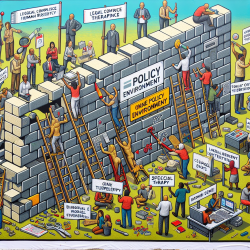Introduction
The landscape of HIV response is riddled with structural barriers that impede effective intervention and access to necessary services. These barriers, often rooted in legal and policy frameworks, create significant challenges for practitioners aiming to deliver comprehensive care. The research article "Identifying Structural Barriers to an Effective HIV Response" provides a detailed examination of these challenges, offering insights that can enhance practitioners' ability to navigate and address these obstacles.
Understanding Structural Barriers
Structural barriers are defined as contextual factors that increase vulnerability to HIV infection or hinder access to related services. These barriers are often entrenched in laws and policies that, while intended to regulate behaviors, inadvertently restrict access to essential services for key populations such as people who inject drugs, men who have sex with men, and sex workers.
The research highlights that 78 governments and civil society in 106 countries report laws and policies that obstruct access to HIV services. This dissonance between legal frameworks and service availability underscores the need for reform and alignment with international human rights commitments.
Implications for Practitioners
For practitioners, understanding the impact of these structural barriers is crucial for developing effective interventions. Here are some strategies to consider:
- Advocacy for Legal Reform: Practitioners can play a pivotal role in advocating for legal reforms that align national laws with human rights standards, thus removing barriers to service access.
- Policy Engagement: Engaging with policymakers to highlight the adverse effects of existing laws on HIV response can drive change and promote supportive legal environments.
- Collaboration with Civil Society: Partnering with civil society organizations can amplify advocacy efforts and ensure that the voices of affected populations are heard in policy discussions.
- Education and Awareness: Raising awareness about the impact of structural barriers can foster a more informed public and encourage community support for necessary legal changes.
Encouraging Further Research
The complexity of structural barriers necessitates ongoing research to fully understand their impact and develop targeted interventions. Practitioners are encouraged to engage in or support research efforts that explore the nuances of these barriers and identify effective strategies for overcoming them.
By participating in research, practitioners can contribute to a growing body of knowledge that informs policy changes and enhances the efficacy of HIV responses globally.
Conclusion
The research article provides a comprehensive overview of the structural barriers affecting HIV responses and underscores the importance of legal and policy reform. Practitioners are in a unique position to advocate for change, engage with policymakers, and support research efforts that aim to dismantle these barriers.
To read the original research paper, please follow this link: Identifying structural barriers to an effective HIV response: using the National Composite Policy Index data to evaluate the human rights, legal and policy environment.










